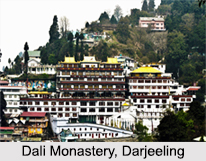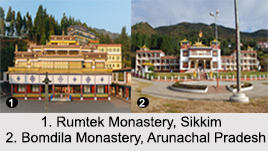 The East Indian cities and towns of Gangtok, Darjeeling, Bomdila, Tawang, Bodh Gaya and Nalanda are cradles of Buddhism and Tibetan Buddhism and the many Gompas standing at these sites are a strong and vibrant reflection of the same, along with being a major factor promoting and boosting tourism in these places. The state of Sikkim and the hill station Darjeeling together alone house over 200 Buddhist monasteries.
The East Indian cities and towns of Gangtok, Darjeeling, Bomdila, Tawang, Bodh Gaya and Nalanda are cradles of Buddhism and Tibetan Buddhism and the many Gompas standing at these sites are a strong and vibrant reflection of the same, along with being a major factor promoting and boosting tourism in these places. The state of Sikkim and the hill station Darjeeling together alone house over 200 Buddhist monasteries.
Monasteries of North East India
The monasteries in North East India are mainly found in the state of Arunachal Pradesh. Tawang Monastery located in Tawang town of the state is the largest monastery in India and second largest in the world after Potala Palace in Lhasa, Tibet. It is an important abode of Mahanaya Buddhism, following the Gelug school. Bomdila Monastery is another revered monastery following Mahanaya Buddhism. Other significant monasteries in the state are Rigyalling Monastery, Urgelling Monastery and Taktsang Gompa.
Monasteries in Darjeeling, West Bengal
 Amongst the multiple monasteries established in the tourist destination Darjeeling, the prominent ones include the Ghoom Monastery, Bhutia Busty Monastery, Dali Monastery and Makdhog Monastery.
Amongst the multiple monasteries established in the tourist destination Darjeeling, the prominent ones include the Ghoom Monastery, Bhutia Busty Monastery, Dali Monastery and Makdhog Monastery.
Monasteries in Sikkim
The organic state of Sikkim has a plethora of Gompas, mostly belonging to Nyingma and Kagyu lineages of Tibetan Buddhism. These include Pemayangtse Monastery at Gyalshing, 140 kilometres from Gangtok, Rumtek Dharma Chakra Centre in Rumtek, 24 kilometres from Gangtok, the hilltop Enchey Monastery, Dubdi Monastery near Yuksum, Tashiding Monastery about 40 kilometres from Gyalshing and Sinon Monastery about 10 kilometres from Tashiding village.
Monasteries in Nalanda
Excavations in the archaeological site of Nalanda, Bihar, have also revealed monasteries that were popular from the Gupta era to the Pala era. The ancient town of Nalanda was an important seat of Buddhism and the monasteries, presently in ruins, are scattered to the east of the main temple and on a higher level. There are remains of two monasteries having their entrances to the north and facing a brick-paved court. The buildings are provided on all four sides with small monk cells each having an entrance facing the concrete-paved balcony, the roof of which was supported by pillars. The shrine chamber of each of the monasteries is situated in the middle of the south row of cells, facing the entrance gate.
Vikramasila Monastery, Bhagalpur, Bihar
Excavations at the village of Antichak in Bhagalpur city of Bihar have exposed a Chaitya complex with two terraces entirely complete with terracotta panels, containing various tantric symbols. The Chaitya may have been the central site of ancient learning. It is surrounded by cells on all sides. These remains have been identified as those of Vikramasila-Mahavihara, a center for advanced studies in Buddhism.



















